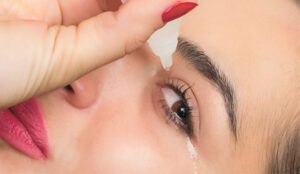By Anne-Marie Chalmers, MD
 From saline eye drop solutions to topical lubricants, Americans spend an astounding $3.8 billion on dry eye symptom relief every year. Not only are many of these treatments inconvenient and uncomfortable to apply, but often the results are also disappointing.
From saline eye drop solutions to topical lubricants, Americans spend an astounding $3.8 billion on dry eye symptom relief every year. Not only are many of these treatments inconvenient and uncomfortable to apply, but often the results are also disappointing.
Current research suggests that chronic inflammation is at the heart of most dry eye issues, including Meibomian Gland Dysfunction (MGD). Since omega-3s are known to help fight inflammation, can these fatty acids also treat dry eye symptoms?
How Do Dry Eye Symptoms Start?
While a number of environmental and behavioral factors can contribute to dry eyes, the most common cause of dry eye disease is Meibomian Gland Dysfunction.
Located behind the upper and lower eyelids, the meibomian glands are responsible for producing meibum – a rich mixture of oils that keeps the eyes moist and comfortable — every time you blink.
Whether due to chronic inflammation or other factors, the meibomian glands can become clogged, preventing the meibum from lubricating the eyes correctly. Without the meibum, the eye has to rely on lower-quality tears that evaporate quickly, leaving the eye surface unprotected. This results in dry eye symptoms (like burning, tearing, redness, and blurry vision).
Over time, clogged meibomian glands can deteriorate, causing MGD. In the early stages, blocked meibomian glands may occur without a person experiencing significant symptoms.
Why Are Omega-3s Beneficial for Dry Eyes?
Omega-3 fatty acids serve a number of important roles in the eye. For one, the fatty acids EPA and DHA are known to both prevent and resolve ongoing inflammation. Less inflammation can potentially lower the risk of MGD from developing in the first place; it can also mean less discomfort after the disease has progressed.
There’s another benefit to omega-3s too. The meibum that the meibomian glands produce is made up of a mixture of wax esters and beneficial fatty acids. Since many people with MGD have an abnormal meibum consistency, it’s believed that increased omega-3 intake can help improve the fatty acid composition and quality of oil in our tears.
Clinical Studies on Dry Eyes and Omega-3s
To date, many clinical trials have found that getting an effective dose of omega-3s may improve tear production, decrease tear evaporation rate, and provide relief for dry eye discomfort.
Sometimes, however, the results are conflicting. For instance, in 2018, a NIH-funded study found that a high dose of omega-3s did not make a significant difference in terms of relieving dry eye symptoms compared to placebo.
This past May 2019, however, two meta-analyses re-examined the data. In both, the scientists concluded that omega-3 supplementation did improve dry eye symptoms and metrics, including tear breakup time, Schirmer test scores, tear osmolarity, and ocular surface disease index scores.
How to Get Benefits from an Omega-3 Supplement
Many MGD treatments (like eye drops) typically only provide temporary relief. But increasing your intake of fresh omega-3s may be an effective way to make improvements long term.
If you’re considering taking fish oil for dry eyes, here are four key points to remember:
1. Get an Effective Dose
For any omega-3 supplement to be effective, getting the right dose of fatty acids is crucial. While the studies involving omega-3s and dry eyes have used a variety of doses to achieve results, numerous scientific reviews suggest that the omega-3s’ anti-inflammatory effects don’t kick in for adults unless you get more than 2000 mg of EPA/DHA daily.
Regular fish oil and cod liver oil supplements often do not provide more than 300 mg of EPA/DHA per capsule, so it’s important to look closely at the supplement facts when choosing an omega-3 product.
2. Give Omega-3 Benefits Time
It takes time for the omega-3 fatty acids to build up in the body and have an effect. Studies indicate that dry eye relief tends to occur after 6-12 weeks of daily supplementation.
Since changes are often gradual and can vary from individual to individual, keeping a journal can be an especially helpful way to monitor your progress.
3. Find a Fresh Fish Oil
While omega-3s are highly beneficial in terms of reducing inflammation, these fatty acids have a molecular structure that makes them extremely prone to oxidation (or spoiling).
Numerous independent studies have found that the majority of omega-3 supplements have turned rancid long before their stated expiration date. Not only are oxidized omega-3 products less potent, but consuming rancid fish oil can also be harmful.
Just like fresh fish, truly fresh fish oil should not taste or smell fishy. If you’re taking fish oil capsules, break one open to taste and smell the contents. If it gives off a bad taste and smell, it’s already oxidized – throw it out!
This article was abbreviated from a longer version published on omega3innovations.com. For the full text and references, visit:
https://omega3innovations.com/blog/5-tips-for-getting-relief-from-dry-eyes-with-an-omega-3-supplement/
About Anne-Marie Chalmers, MD
Born and raised in the United States, Dr. Chalmers graduated from Brown University and completed her medical training at the University of Oslo in Norway. Dr. Chalmers practiced emergency, family, and preventive medicine in Norway for many years. Today, she serves as president of Omega3 Innovations.
Omega3 Innovations
941-485-4400
www.Omega3Innovations.com
 Central Florida Health and Wellness Magazine Health and Wellness Articles of the Villages
Central Florida Health and Wellness Magazine Health and Wellness Articles of the Villages



